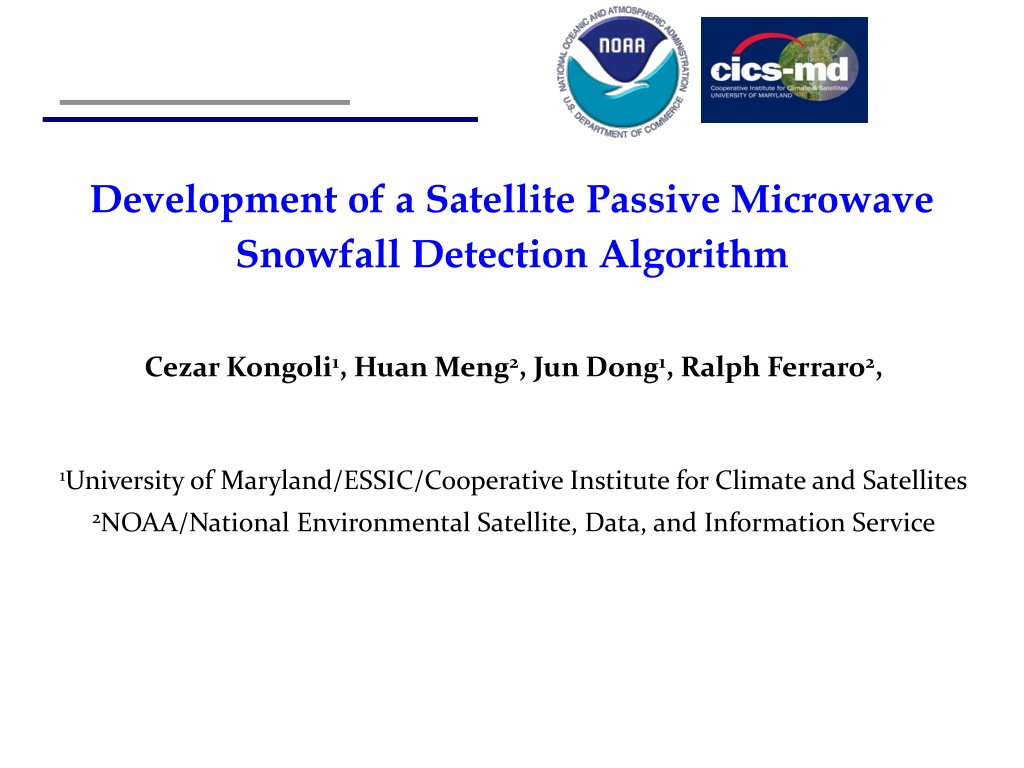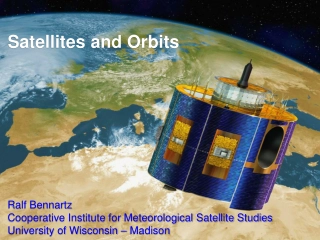Development of Satellite Passive Microwave Snowfall Detection Algorithm
This study focuses on the development of a satellite passive microwave snowfall detection algorithm, highlighting the challenges in accurately determining snowfall using satellite instruments. The algorithm uses data from AMSU/MHS, ATMS, and SSMIS sensors to generate snowfall rate estimates, overcoming limitations of traditional VIS/IR measurements. The historical perspective reveals advancements in snowfall detection, such as the MSPPS AMSU algorithm. The new detection algorithm combines principal components and logistic regression models to improve accuracy. Additionally, it discusses the extension to cold regime satellite measurements based on atmospheric conditions.
Download Presentation

Please find below an Image/Link to download the presentation.
The content on the website is provided AS IS for your information and personal use only. It may not be sold, licensed, or shared on other websites without obtaining consent from the author. Download presentation by click this link. If you encounter any issues during the download, it is possible that the publisher has removed the file from their server.
E N D
Presentation Transcript
Development of a Satellite Passive Microwave Snowfall Detection Algorithm Cezar Kongoli1, Huan Meng2, Jun Dong1, Ralph Ferraro2, 1University of Maryland/ESSIC/Cooperative Institute for Climate and Satellites 2NOAA/National Environmental Satellite, Data, and Information Service
Product Overview Probability-based Snowfall Detected (SD) area over global land; Snowfall mask for 1DVAR-based SnowFall Rate (SFR) (Meng et al. 2016, submitted to JGR) generated from AMSU/MHS sensor pair (POES/Metop) and ATMS (S-NPP and the future JPSS satellites); The five satellites produce up to ten snowfall rate estimates per day at mid- latitudes and more estimates at higher latitudes; A similar SSMIS-based SD/SFR product is under development. Retrieved Snowfall Rate NEXRAD Reflectivity 2
A Brief Historical Perspective (1) Operational snow cover algorithms from VIS/IR and passive MW have over 40-year history. Real progress on snowfall determinations began only with the launch of satellites carrying AMSU-A/B/MHS instruments. WHY? Very difficult to discriminate winter snowfall from no-snowfall clouds or snow on the ground using VIS/IR measurements; Passive MW measurements at 89 GHz and above are sensitive to snowfall-sized ice particles. WV channels around 180 GHz are even better since WV screens out surface effects. 3
A Brief Historical Perspective (2) MSPPS AMSU snowfall detection algorithm was the first operational product (Kongoli et al., 2003; Ferraro et al. 2005). Historical MSPPS images available at: http://www.star.nesdis.noaa.gov/corp/scsb/mspps/ A decision tree binary classification with retrievals limited to warmer weather. Colder weather retrievals were found too noisy and removed from the product. 4
New Snowfall Detection Algorithm Coupled principal components and logistic regression model (Kongoli et al., 2015); Input data: 53.6 GHz and all high frequency channels above 89 (MHS) /88.2 GHz (ATMS); Model output is the probability of snowfall; preset thresholds for snowfall; Training data sets are composed of matching satellite and ground snowfall observation data; Additional filters and screenings to improve the accuracy of snowfall detection. Snowfall Freq. vs. 2 m RH 5
Extension to Cold Regime Satellite measurements exhibit different characteristics depending on atmospheric conditions: Scattering signal dominates in relatively warm and moist atmosphere Emission signal dominates in cold and dry atmosphere (or with abundant supercooled liquid water) Limb-corrected temperature sounding channel 53.6 GHz (Tb53L) as a proxy for atmospheric temperature Tb53L is used to define retrieval regimes: Too warm, no snow (> 252K) Warm regime (244K ~ 252K) Cold regime (240K ~ 244K) Too cold, no retrieval (< 240K) SD models are trained separately for cold and warm regimes. Snowfall Freq. vs. Tb53L 6
Tb53L a strong predictor of near surface temperature Snowfall No-Snowfall 7
Two-Regime Hypothesis Strong Empirical Evidence: Change of direction in the correlation between measured SFR and TBs SFR (mm/hr) Variable temp hum TB89 TB165 TB176 TB179 TB180 TB181 TB182 TB53L Regime 1 Regime 2 0.13 0.06 -0.07 -0.20 -0.23 -0.23 -0.21 -0.17 -0.05 0.10 0.10 0.10 0.09 0.08 0.06 0.04 0.03 0.03 -0.01 0.10 8
Extension to Cold Regime Cold regime extension is a new development for ATMS SFR, also applied to the AMSU/MHS algorithm No Cold Extension With Cold Extension Radar Reflectivity 9
New Snowfall Detection Procedure SD Procedure Apply filters and determine snowfall regime; Run the statistical model to derive snowfall probability; Compare with probability threshold to obtain Snowfall Detection Index Apply NWP based screening to derive the final SD product . Snowfall Probability Snowfall Rate Snowfall Detection Index NEXRAD Composite Reflectivity 10
SD Validation (1) SD algorithm was evaluated with in-situ data as ground truth for snowfall events over CONUS and Alaska that spread out over different regions and time of year; 62% of ground truth data is very light snowfall reported as trace challenging to detect for satellite product; Evaluation included an investigation of error sources and sensitivity to the probability of snowfall, snowfall intensity, elevation, zenith angle and additional model-based screening. Statistics: Probability of Detection (%) 51 False Alarm Rate (%) 9.5 Heidke Skill Score 0.45 11
SD Validation (2) Other Conclusions SD performance is comparable over high and low elevation areas; Statistics improve with snowfall rate; Statistics degrade for shallow to moderate cloud snowfall; The most effective screening parameters are cloud thickness and relative humidity; 12
On-going/Future Work Hybrid weather forecast-satellite snowfall detection model Probability Logistic Regression model based on Numerical Weather Prediction (NWP) model data; Coupled Principal Components and Probability Logistic Regression model based on satellite TBs; Hybrid model: Optimal weighting of both: Prob_hybrid = W1*Prob_wea +W2*Prob_sat W1+W2 = 1 13
Weather-based Model Statistics GFS-derived weather variables considered: cloud thickness, relative humidity and vertical velocity at 1,2 and 3 km height, cloud top height and temperature; 1-km relative humidity and cloud thickness the most statistically significant to discriminate snowfall from no-snowfall cases including moderate to shallow-cloud snowfall (cloud thickness less than 3.5 km). 14
Weather-based model Statistics (2) No-snowfall Snowfall Forecast relative humidity histograms at 1 km height for no- snowfall (left) and snowfall (right) cases. For rel. humidity at and above 90 %, 75% of all snowfall cases are detected with 25% false alarm. 15
Weather-based Model Statistics (3) No-snowfall Snowfall GFS-derived cloud thickness for no-snowfall (left) and snowfall (right) cases. For cloud height over 3500 m, 55% of all snowfall cases are detected with less than 10% false alarm 16
Weather-based Model Statistics (4) Variables in the Equation B S.E. Wald df Sig. Exp(B) Hum1 Step 6a .033 .001 1440.086 1 .000 1.033 Hum3 -.004 .001 29.394 1 .000 .996 hum .034 .001 606.497 1 .000 1.035 V2 .000 .000 88.362 1 .000 1.000 V3 -.001 .000 214.769 1 .000 .999 Cthick .001 .000 1182.353 1 .000 1.001 Constant -6.908 .131 2761.055 1 .000 .001 Classification Tablea Predicted Snowcode Observed Snowcode 0 1 Percentage Correct Step 6 0 22535 4546 83.2 1 4644 11777 71.7 Overall Percentage 78.9 a. The cut value is .500 17
Hybrid Model Application Examples The blended (0.5:0.5) weather-satellite snowfall detection model for both shallow and thick-cloud snowfall Deep-Cloud Snowfall Case Shallow-Cloud Snowfall Case Deep-Cloud Snowfall Case Radar Reflectivity
Future Development Development of SSMIS and GMI algorithms Development of ocean algorithms 19
Acknowledgement JPSS Proving Ground and Risk Reduction Program NOAA/NESDIS NASA Thank You! 20























